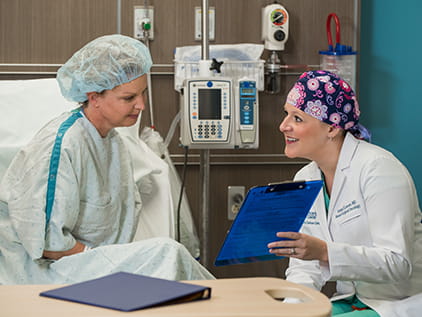August 23, 2020
Ovarian cancer ranks 5th in cancer deaths among women and causes more deaths than any other cancer of the female reproductive system. A woman’s lifetime risk of getting ovarian cancer is about 1 in 78, while her risk of dying from it is 1 in 108. Ovarian cancer can be asymptomatic for several years, which makes it challenging to diagnose.
There is some good news: Overall, cancer rateshave declined over the past 20 years. For 2020, the American Cancer Society estimates there will be 21,750 new cases of ovarian cancer and that 13,940 women will die from the disease. This is why it's important to empower yourself with knowledge.
What is ovarian cancer?
Women have 2 ovaries. The oval-shaped reproductive organs produce eggs that travel through fallopian tubes into the uterus (usually). There is 1 ovary and 1 fallopian tube on each side of the uterus. If fertilized, the egg implants into the uterine wall where the embryo develops. Ovaries also produce hormones like estrogen and progesterone.
Cancer occurs when cells grow out of control in any area of the body and form tumors. If that cancer spreads, it is known as metastasizing. In ovarian cancer, the cells abnormally grow in the ovaries or the fallopian tubes. In fact, recent research shows that most ovarian tumors may start in the fallopian tubes.
Tumors can be one of the following:
- Noncancerous (benign): Does not spread
- Malignant (cancerous): Invasive, likely to spread
- Borderline with low malignant potential: Possibly spreads, but less likely to than malignant
The ovaries contain 3 types of cells: epithelial, stroma and germ cells. The type of tumor that develops depends on the cells involved:
- The most common type of ovarian tumor is an epithelial tumor, which starts from the cells on the outside of the ovary. Nearly 90% of malignant ovarian cancers are epithelial tumors. These are called carcinomas. They are broken down into subtypes based on microscopic differences:
- Serous carcinomas (52%)
- Endometrioid carcinoma (10%)
- Clear cell carcinoma (6%)
- Mucinous carcinoma (6%)
- Germ cell tumors occur in the egg-producing cells. Only 2% of ovarian cancers are germ-cell tumors. Most germ-cell tumors are benign, but even those that are malignant have a good prognosis – more than 90% of patients survive at least 5 years following diagnosis.
- Stromal tumors start in the cells that produce hormones and hold the ovary together. Only 1% of ovarian cancer arises from stromal cell tumors. The majority of women with ovarian cancer are age 50 or older, but 1 in 20 cases occurs in young girls. Because they produce hormones, young women may experience abnormal bleeding or a sudden stop in menses. Stromal tumors are often found in the early stages and have a good prognosis with more than 75% of patients surviving long term.
What are the most common symptoms of ovarian cancer?
The symptoms of ovarian cancer are typically vague (such as indigestion and bloating) and early-stage ovarian cancer has no symptoms. This means that ovarian cancer often goes undiagnosed until its later stages, when the cancer is more likely to have spread.
Common symptoms of ovarian cancer include:
- Unexplained and frequent bloating
- Feeling full quickly after eating
- Difficulty eating or lack of appetite
- Pelvic pain
- Abdominal pain or cramping
- The need to urinate more frequently or urgently than normal
Additional symptoms to note:
- Indigestion or upset stomach
- Nausea
- Pressure in lower back or pelvis
- Unexplained exhaustion
- Back pain
- Constipation
- Abdominal swelling
- Painful sex
- Menstrual changes
- Weight loss
When ovarian cancer recurs, symptoms are the same as those above. If you have a history of ovarian cancer and are experiencing any of the symptoms noted, contact your healthcare provider immediately.
What can mimic the symptoms of ovarian cancer?
The symptoms of ovarian cancer are confusing because they share the traits of many other conditions. Just because you are experiencing symptoms does not mean that you have ovarian cancer.
There are many other possible diagnoses, such as:
- Ovarian cysts: Fluid-filled pouches in or around the ovaries
- Irritable bowel syndrome: A chronic digestive disorder
- Premenstrual syndrome: Menstrual symptoms in the days leading up to your period
- Endometriosis: Abnormal growth of the uterine lining outside of the uterus on surrounding tissue
- Menses: Your normal menstrual cycle can include pelvic cramps and abdominal discomfort
- Uterine fibroids: Benign muscular tumors that grow in the uterine wall. They typically are harmless unless they become too large.
- Pelvic infection: Sexually transmitted disease or pelvic inflammatory disease
Do ovarian cancer symptoms come on suddenly?
Ovarian cancer symptoms are typically difficult to recognize because they are similar to those of other conditions. Experts advise that anyone who experiences unexplained abdominal symptoms lasting for more than 2 weeks should see their healthcare provider.
How long can ovarian cancer go undetected?
Ovarian cancer can go undetected for years without revealing its existence. Unfortunately, ovarian cancer symptoms are vague and at this time there is no accurate way to identify the disease in its earliest stages. As a result, ovarian cancer often goes undetected until it has spread throughout the pelvis and abdomen. At this later stage, the disease is more challenging to treat. The earlier that ovarian cancer is detected, the better the outcome.
How can you detect ovarian cancer early?
If you are BRCA positive, you should see a gynecologist and have regular pelvic exams. It’s critical to see your healthcare provider regularly.
If you are symptomatic or at increased risk for ovarian cancer, there are some tests that your healthcare provider may order:
- The CA-125 blood test looks for blood protein that increases in people with cancer. If it is elevated, don’t worry – it is not specific for ovarian cancer. It can grow with other conditions like endometriosis, pregnancy, fibroids, pancreatitis, ovarian cysts, liver cirrhosis and your menses.
- A transvaginal ultrasound is a pelvic ultrasound where an oblong probe is inserted into your vagina to examine your ovaries and surrounding tissue. A TVUS is the first-line of imaging for possible pelvic issues.
- Other imaging options may include computed tomography or magnetic resonance imaging.
What makes early detection of an ovarian tumor so tricky?
The early symptoms of ovarian cancer are vague and difficult to pinpoint. Unfortunately, by the time you notice symptoms, the cancer may have progressed. Unlike breast or cervical cancer, there are no screening tests available to identify ovarian cancer in the early stages.

Genetic testing and counseling
Genetic counselors at our nationally recognized cancer center identify and manage cancer risk through genetic testing and risk assessment.
Does ovarian cancer spread quickly?
Ovarian cancer grows quickly and can progress from early stages to advanced within a year. With the most common form, malignant epithelial carcinoma, the cancer cells can grow out of control quickly and spread in weeks or months.
It is critical to pay attention to symptoms, which may help improve your chances of being diagnosed early and treated promptly. Detecting cancer while it is early will improve the prognosis. Unfortunately, 80% of ovarian cancer patients are not diagnosed until the disease has spread throughout their abdominal cavity.
What are the different stages of ovarian cancer?
The International Federation of Gynecology and Obstetrics staging system measures the size of the tumor, how invasive it is and whether it has spread.
It is crucial to accurately determine the stage so that your care team will know how to treat you and what your prognosis will be. Surgical removal ensures accurate staging of ovarian cancer.
There are 4 stages:
- Stage 1 is limited to 1 or both ovaries.
- Stage 2 is in 1 or both ovaries and has spread elsewhere in the pelvis.
- Stage 3 is 1 or both ovaries and the lining or the lymph nodes of the abdomen.
- Stage 4 has metastasized or spread to distant organs and is considered an advanced stage of ovarian cancer.
The stages of ovarian cancer can further be broken into the following categories.
- 1A: Limited to 1 ovary
- 1B: Limited to both ovaries
- 1C: One or both ovaries contain cancer cells and
- The outer capsule broke before or during surgery
- There are cancer cells on the outside of the ovary
- Cancer cells are found in fluid washings of the abdomen
- 2A: The cancer is in 1 or both ovaries and has spread to the fallopian tubes, uterus or both
- 2B: Cancer is in 1 or both ovaries and has migrated to bladder, colon or rectum
- 3A: Cancer is in other pelvic organs and lymph nodes within the abdominal cavity or lining
- 3B: Cancer has spread to nearby organs within the pelvis and is found on the outside of the spleen, liver or lymph nodes
- 3C: Larger deposit of cancer cells found outside spleen or liver, or it has spread to lymph nodes
- 4A: Cancer cells are present in the fluid around the lungs
- 4B: Cancer cells are inside the spleen, liver, distant lymph nodes or the skin, lungs and brain
Who is at risk for ovarian cancer?
- Age: Risk increases for women over age 50, but most cases are diagnosed at age 65 or above.
- Obesity: Increases lifetime risk for ovarian cancer by about 2%.
- Use of talcum powder in the genital area: Increases lifetime risk by about 0.5%.
- Endometriosis: Causes cell changes throughout the reproductive organs and slightly increases the risk for ovarian cancer.
- Hormone replacement therapy: 5 years of HRT results in 1 additional ovarian cancer diagnosis per 1,000 HRT users.
- Smoking: Increases the risk of ovarian cancer by approximately 3%.
- Diabetes: Increases your risk of developing ovarian cancer by 20%-25%.
What causes ovarian cancer?
The most common risks for ovarian cancer include a personal or family history of breast or ovarian cancer. Women with Lynch syndrome are also at increased risk for ovarian cancer.
Ovarian cancer can also be hereditary. If you have a strong family history of ovarian or breast cancer, you may have a mutation that affects the BRCA1 or BRCA2 genes.
What is BRCA1 or BRCA2?
Normally, BRCA1 and BRCA2 are tumor suppressor genes that halt abnormal cell growth in the ovaries. If 1 of these genes mutates, it can increase your risk of developing cancer. You have a 50% chance of inheriting the BRCA gene mutation if 1 of your parents has it.
Women with a mutation in either their BRCA1 or BRCA2 genes have 10-to-30 times increased risk of ovarian cancer. BRCA1 increases the chance of ovarian cancer even more than BRCA2.
Genetic testing for BRCA1 or BRCA2 gives you information about your predisposition of developing ovarian cancer. While it sounds rare, 1 in every 500 women in the United States has a BRCA1 or BRCA2 gene mutation.
What are the protective factors for ovarian cancer?
The birth control pill, also known as a combined oral contraceptive, has other benefits than preventing pregnancy. The pill can decrease your risk of ovarian cancer by nearly half if taken for 10 years. However, birth control pills can increase your risk for other diseases, so weigh the benefits and risks with a trusted healthcare provider.
Pregnancy and breastfeeding reduce the chance of developing ovarian cancer. The fewer ovulatory cycles that a woman has (by pregnancy, breastfeeding or birth control), the less risk she has for ovarian cancer during her lifetime. Breastfeeding often decreases the number of cycles that a woman experiences.
A hysterectomy with removal of the fallopian tubes and ovaries decreases the risk for ovarian cancer. However, many women who undergo a hysterectomy leave their ovaries in place so they maintain their normal hormones.
How can you treat ovarian cancer?
Ovarian cancer treatment options include surgery and chemotherapy or targeted therapy. Surgery involves removing the affected ovary (ovaries) or the ovaries, fallopian tubes and uterus and performing a biopsy to evaluate cancer cells.
- Surgery is the primary treatment. You can choose to remove the ovary and tissue affected by cancer. However, some women prefer to remove both ovaries and their uterus and fallopian tubes to reduce the risk of recurrence.
- Chemotherapy is a treatment that enters your bloodstream and destroys cancer cells. It can be beneficial, but it also damages the body’s healthy cells.
- Hormone therapy blocks the production of hormones that cause tumors to grow and spread.
- Targeted therapy is a newer treatment that kills cancer cells but minimizes damage to healthy cells.
- Radiation therapy is for cancer that has spread beyond the ovaries. It uses energy particles and X-rays to destroy cancer cells.

Your best option for beating cancer
The Women’s Cancer Center at The University of Kansas Cancer Center focuses on breast and gynecologic cancers, providing specialized care to women.
Can you fully recover from ovarian cancer?
Yes, many women fully recover from ovarian cancer following surgery and/or chemotherapy. Ovarian cancers caused by stromal or germ cell tumors have high survival rates. However, epithelial carcinoma is the most common type of ovarian cancer and has lower survival rates.
The 5-year-survival rate for malignant epithelial carcinoma at various stages follows:
- Localized (stage 1) is 92%
- Regional (stage 2 or 3) 76%
- Distant (stage 4) 30%
- All stages combined 47%
Where should I seek diagnosis and treatment?
The University of Kansas Cancer Center is the only National Cancer Institute-designated cancer center in the region. The cancer center is transforming the ovarian cancer patient experience by providing compassionate care and support throughout your diagnosis and by offering the latest and most innovative ovarian cancer treatments.
The Women's Cancer Center focuses solely on women's cancers, including breast and gynecologic disease. Our cancer care teams are dedicated to improving patient outcomes.
Start your path today.
Your journey to health starts here. Call 913-588-1227 or request an appointment at The University of Kansas Cancer Center.
